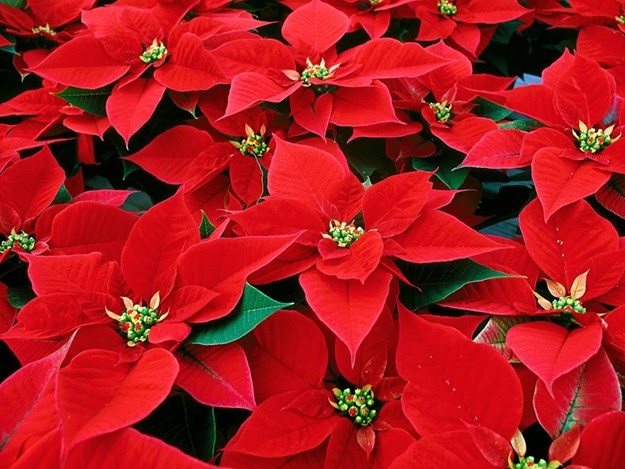Caring For Your Beautiful Poinsettia Year-Round
By: Dr. Patrick E. Igbokwe, Professor and Director
Alcorn State University Experiment Station
An Overview:
Using poinsettias (Euphorbia pulcherrima) to enhance the outlook and attractiveness of homes, schools, hospitals, churches, and shopping centers during the holiday season has become a tradition all over the world.
This holiday plant belongs to the family Euphorbiaceae Juss., which includes large and diverse plants, ranging from leafy annuals to cactus-like succulents and trees. It is the number one potted flowering crop in the United States sold during the Christmas holidays. It is grown as a hanging basket, and occasionally as a cut flower. The poinsettia is also grown for its large, and striking bract clusters, the center of which contain the small true flowers known as cyathia.
To care for this beautiful plant during the holiday season and beyond, the suggested tips below could be helpful.
1.Care During the Christmas Season: The factors to monitor carefully during the holiday season are light, heat, water and humidity:
Light – Place your poinsettia near a sunny window. South, east or west facing windows are preferable to a north facing window. Poinsettias are tropical plants and will appreciate as much direct sunlight as you can provide.
Heat – To keep the poinsettia in bloom as long as possible, maintain a temperature of 65-75 degrees F during the day. Dropping the temperature to about 60 degrees F at night will not hurt the plant. However, cold drafts or allowing the leaves to touch a cold window can injure the leaves and cause premature leaf drop. If you've ever seen a gangly poinsettia in bloom, with only a couple of sad looking leaves hanging on, it was probably exposed to temperatures that were too cool or extreme shifts in temperature.
Water – Water the plant whenever the surface feels dry to the touch. Water until it drains out the bottom, but don't let the plant sit in water. Wilting is another common cause of leaf drop. A wilted plant can be revived and salvaged, but it will take another season to improve its appearance.
Humidity – Lack of humidity during dry seasons, in particular winter, is an ongoing houseplant problem.
If your home tends to be dry and your poinsettia is in direct light, you will find yourself watering frequently, possibly every day.
2. After Christmas Care: After the holiday, the monthly management practices are:
January – March: Keep watering the poinsettia whenever the surface is dry.
April: Starting April 1, gradually decrease water, allowing them to get dry between watering. Be careful the stem does not begin to shrivel. This is a sign the plant is too stressed and is dying. In a week or two, when the plant has acclimated to this drying process, move it to a cool spot like the basement or a heated garage. You want to keep it at approximately 60 degrees F.
May: In mid-May, cut the stems back to about 4 inches and repot in a slightly larger container, with new potting soil. Water it well. Place the newly potted plant back into the brightest window you have and once again keep it at a temperature of 65-75 degrees F. Continue watering whenever the surface of the soil feels dry.
Watch for new growth. Once new growth appears, begin fertilizing every two weeks with a complete fertilizer. Follow fertilizer label recommendations.
June: Move the poinsettia outside. Keep it in a partially shaded location and maintain your watering and fertilizing schedule.
July: In early July, pinch back each stem by about one inch. This is to encourage a stout, well-branched plant. If left unpinched, the poinsettia will grow tall and spindly.
August: By mid-August, the stems should have branched and leafed out. Once again, pinch or cut the new stems, leaving 3-4 leaves on each shoot. Bring the plant back indoors and back into your brightest window. Continue watering and fertilizing.
September: Continue regular watering and fertilizing. Make sure the temperature stays above 65 degrees F.
October Poinsettias are short-day plants, meaning their bud set is affected by the length of daylight. To re-bloom, poinsettias need about 10 weeks with 12 hours or less of sunlight per day. You will have to artificially create these conditions and it's crucial that you be diligent. This is only for varieties that are sensitive to exposure to light at night.
Beginning October 1, keep your plant in complete darkness from 5 p.m. to 8 a.m. Any exposure to light will delay blooming. Use an opaque box or material to block out light. Many people place their plants in a closet, but if light gets in through the cracks or if you open and use the closet, it will affect the bud set.
Move the plant back to the sunny window during the daytime and continue watering and fertilizing.
November: Around the last week of November, you can stop the darkness treatment and allow the plant to remain in the window. You should see flower buds at this point
December – Stop fertilizing about December 15. Keep watering and treat your plant the way you did when you first brought it home in bloom. If all has gone well, it should be back in bloom and ready to begin the process all over again.
For more Information:
Dr. Patrick E. Igbokwe
Professor and Director, Alcorn Experiment Station
Lorman, MS 39096-7500
601-877-6542
Reference:
Dole J. M. and Wilkins H.F. 1999. Floriculture Principles and Species. Prentice- Hall,
Upper Saddle River New Jersey. pp. 331-345





